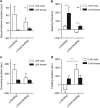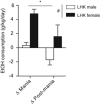Sex differences in mania phenotype and ethanol consumption in the lateral hypothalamic kindled rat model
- PMID: 25803497
- PMCID: PMC4354358
- DOI: 10.1038/tp.2015.30
Sex differences in mania phenotype and ethanol consumption in the lateral hypothalamic kindled rat model
Abstract
Sex differences have been observed in mania phenotypes in humans. However the mechanisms underlying this difference are poorly understood. Activating the lateral hypothalamus is implicated in manic-like behaviors in rodents. Using newly established lateral hypothalamus kindled (LHK) rat mania model, we investigated sex differences of manic-like behaviors and its correlation with voluntary ethanol intake. We stimulated the lateral hypothalamus bilaterally in the male and female Wistar rats over five consecutive days. We recorded and quantified kindling-induced behaviors for each individual animal. We also assessed ethanol consumption using a two-bottle choice ethanol drinking as well as circadian locomotor activity counts daily throughout the experiment. We found notable sex differences in several aspects of manic-like behaviors during kindling. Males exhibited a significantly increased locomotor activity during the light phase, and reduced rest interval. On the other hand, females displayed significantly higher ethanol consumption and more frequent rearing behavior. However, no sex differences were present in the duration of sexual, feeding or grooming behaviors or in dark-phase activity counts. The excessive alcohol intake in LHK female rats is reminiscent of clinically reported sex differences in bipolar patients while the other phenotypic sex differences such as rearing and locomotor activity are less clearly described in clinical studies. Overall, our results lend further evidence for the validity of the LHK rat as a useful model to study brain region-specific molecular changes during mania and its correlation with alcohol use disorders.
Figures




Similar articles
-
No differences in manic-like behaviors between voluntary ethanol and water drinking in Lateral Hypothalamic Kindled (LHK) alcohol preferring rats.Psychiatry Res. 2018 Mar;261:186-189. doi: 10.1016/j.psychres.2017.12.075. Epub 2018 Jan 2. Psychiatry Res. 2018. PMID: 29309958 Free PMC article.
-
Lateral hypothalamic kindling induces manic-like behavior in rats: a novel animal model.Int J Bipolar Disord. 2014 Dec;2(1):7. doi: 10.1186/s40345-014-0007-8. Epub 2014 Jun 14. Int J Bipolar Disord. 2014. PMID: 26092394 Free PMC article.
-
Intermittent voluntary ethanol consumption combined with ethanol vapor exposure during adolescence increases drinking and alters other behaviors in adulthood in female and male rats.Alcohol. 2018 Dec;73:57-66. doi: 10.1016/j.alcohol.2018.04.003. Epub 2018 Apr 18. Alcohol. 2018. PMID: 30293056 Free PMC article.
-
Circadian activity rhythms and voluntary ethanol intake in male and female ethanol-preferring rats: effects of long-term ethanol access.Alcohol. 2014 Nov;48(7):647-55. doi: 10.1016/j.alcohol.2014.07.010. Epub 2014 Sep 16. Alcohol. 2014. PMID: 25281289 Free PMC article.
-
Intermittent ethanol access schedule in rats as a preclinical model of alcohol abuse.Alcohol. 2014 May;48(3):243-52. doi: 10.1016/j.alcohol.2014.01.006. Epub 2014 Mar 15. Alcohol. 2014. PMID: 24721195 Free PMC article. Review.
Cited by
-
Sex difference in the progression of manic symptoms during acute hospitalization: A prospective pilot study.Brain Behav. 2020 Mar;10(3):e01568. doi: 10.1002/brb3.1568. Epub 2020 Feb 13. Brain Behav. 2020. PMID: 32053271 Free PMC article.
-
Corticosterone oscillations during mania induction in the lateral hypothalamic kindled rat-Experimental observations and mathematical modeling.PLoS One. 2017 May 18;12(5):e0177551. doi: 10.1371/journal.pone.0177551. eCollection 2017. PLoS One. 2017. PMID: 28542167 Free PMC article.
-
No differences in manic-like behaviors between voluntary ethanol and water drinking in Lateral Hypothalamic Kindled (LHK) alcohol preferring rats.Psychiatry Res. 2018 Mar;261:186-189. doi: 10.1016/j.psychres.2017.12.075. Epub 2018 Jan 2. Psychiatry Res. 2018. PMID: 29309958 Free PMC article.
-
Animal models for bipolar disorder: from bedside to the cage.Int J Bipolar Disord. 2017 Oct 13;5(1):35. doi: 10.1186/s40345-017-0104-6. Int J Bipolar Disord. 2017. PMID: 29027157 Free PMC article. Review.
-
Antipsychotic-like effects of a neurotensin receptor type 1 agonist.Behav Brain Res. 2016 May 15;305:8-17. doi: 10.1016/j.bbr.2016.02.019. Epub 2016 Feb 22. Behav Brain Res. 2016. PMID: 26909848 Free PMC article.
References
-
- Bebbington P, Ramana R. The epidemiology of bipolar affective disorder. Soc Psychiatry Psychiatr Epidemiol. 1995;30:279–292. - PubMed
-
- Grant BF, Stinson FS, Hasin DS, Dawson DA, Chou SP, Ruan WJ, et al. Prevalence, correlates, and comorbidity of bipolar I disorder and axis I and II disorders: results from the National Epidemiologic Survey on Alcohol and Related Conditions. J Clin Psychiatry. 2005;66:1205–1215. - PubMed
-
- Martinez-Ortega JM, Jurado D, Gutierrez-Rojas L, Molero P, Ramos MA, Gurpegui M. Stability of sex differences by diagnosis in psychiatric hospitalizations. Psychiatry Res. 2012;198:161–163. - PubMed
-
- Akiskal HS, Hantouche EG, Bourgeois ML, Azorin JM, Sechter D, Allilaire JF, et al. Gender, temperament, and the clinical picture in dysphoric mixed mania: findings from a French national study (EPIMAN) J Affect Disord. 1998;50:175–186. - PubMed
-
- Baldessarini RJ, Tondo L, Visioli C. First-episode types in bipolar disorder: predictive associations with later illness. Acta Psychiatr Scand. 2014;129:383–392. - PubMed
Publication types
MeSH terms
Grants and funding
LinkOut - more resources
Full Text Sources
Other Literature Sources
Medical

